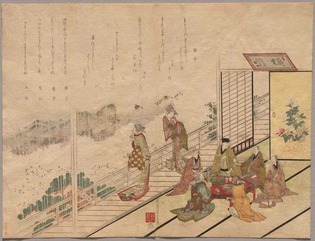 loading
loading
Arts & CultureAn invitation to a banquetA Japanese print combines art and poetry. Sadako Ohki is the YUAG Japan Foundation Associate Curator of Japanese Art. The Virginia Shawan Drosten and Patrick Kenadjian ’70 collection of some 300 surimono are promised gifts to the Gallery. All poems were translated by Adam Haliburton.  Harukawa Goshichi: “Banquet at the Sagamiya Restaurant in Higashiyama.” 2018.116.7“The sound of water, real and yet a dream.” This 1817 woodblock print is more than an exquisite image; it’s also a work of poetry, calligraphy, and commemoration. It is one of 34 such prints that will join other Asian collections on view in the Yale University Art Gallery in early 2021. View full imageIn Japanese, surimono literally means “printed things,” but this modest name for a print is misleading. Surimono are intricately made and privately commissioned woodblock prints of extraordinary beauty. To appreciate the multilayered richness of surimono, let us look at a particularly fine example. It is a beautiful spring evening in 1817, and we have a fascinating view, peeking down from an imaginary blown-off roof into the Sagamiya Restaurant in the Eastern Hills of Kyoto. We know this date and the name and location of the building—in Higashiyama district—because the plaque above the sliding door tells us. A banquet is in progress; five men and one woman are seated around a sumptuous red-lacquered table, drinking wine, while two women are on the balcony, one admiring the view of the verdant hillside in spring rain. We have clues that lead us to believe that the man in the orange haori jacket with his back to us is the restaurant owner, while the man seated prominently in the center, wearing a black cap, is the patron of the gathering. The three men are kabuki actors, and the three women are courtesans. We lift our eyes to the delicate poems seemingly suspended in space above the balcony, and we begin to learn a lot more about this banquet. The poems are haiku, or 17-syllable poems, and they were composed by each of the participants. The first poem on the right was composed by the restaurant owner, and it is signed Kippei (meaning “Mandarin Orange Peace”). The last poem, on the farthest left, a place of honor in surimono, is signed Doran (“Earth Egg”), who was an aristocrat and the patron. Poetry groups such as this one, drawing members from different echelons of society, proliferated in Japan during the peaceful Edo period (1615–1868). The second poem from the right reads, “A night in spring—the sound of water, real and yet a dream”; the third poem says, “What a joy to learn, right where I sit, of flowers and wine.” They were composed by two of the courtesans. Following their compositions are poems by each of the kabuki actors, one of which reads, “There amid the flowers, a raft; a raft in the rain.” A straight and vertical rain falls softly beyond the diagonal of the balcony. The artist, Harukawa Goshichi (1776–1831), has sprinkled the scene with impressive skill. The panoramic view of the Eastern Hills is shrouded in misty clouds. The Tower of Yasaka appears at a distance, while closer, just beyond the balcony, the delicately debossed cherry blossoms hide in plain view above green pine-needle clusters. By using thick mulberry washi paper in the largest possible size, the artist was able to embed rich details in the time-consuming gaufrage technique. Surimono epitomizes the collaborative efforts of the poet, the designer, the calligrapher, the wood block carver, and the print maker. It also illustrates a highly nuanced and personal interplay between word and image, nature and culture. Surimono production peaked in Japan, mostly around Edo—present-day Tokyo—between the late 1810s and 1830s.
The comment period has expired.
|
|